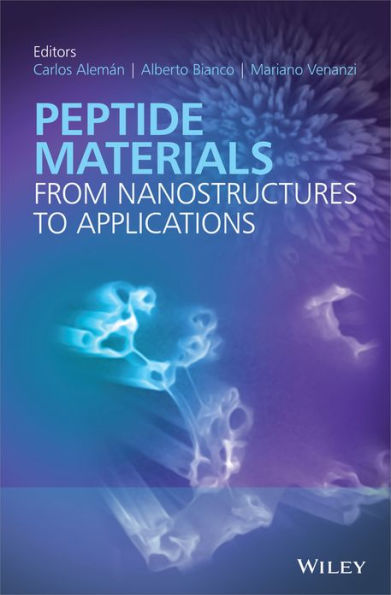Table of Contents
Preface xiii
List of Contributors xvii
Part I Fundamentals of Peptide Materials 1
1 Physics of Peptide Nanostructures and Their Nanotechnology Applications 3
Nadav Amdursky, Peter Beker and Gil Rosenman
1.1 Introduction to Peptide Nanotubes 4
1.2 Optical Properties and Quantum Confinement of FF-based Nanostructures 8
1.3 Odd-Tensor Related Physical Properties 13
1.4 Thermal Induced Phase Transition in Peptide Nanotubes 17
1.5 Deposition Techniques of PNT 22
1.6 Applications of PNTs 29
1.7 Conclusion 32
References 33
2 Chemistry of Peptide Materials: Synthetic Aspects and 3D Structural Studies 39
Fernando Formaggio, Alessandro Moretto, Marco Crisma and Claudio Toniolo
2.1 Introduction 40
2.2 Synthesis of Difficult Peptide Sequences 40
2.3 Peptide (Amide) Bond 43
2.4 Peptide Torsion Angles 44
2.5 Peptide Secondary Structures 46
References 58
3 Conformational Aspects and Molecular Dynamics Simulations of Peptide Hybrid Materials: From Methods and Concepts to Applications 65
Carlos Alemán, Oscar Bertran, Jordi Casanovas, Juan Torras, Guillermo Revilla-López and David Zanuy
3.1 Computational Chemistry 66
3.2 Quantum Mechanical Calculations: Concepts 67
3.3 Quantum Mechanical Calculations on Hybrid Peptide Materials: Some Examples 72
3.4 NCAD: An Information Management System of Quantum Mechanical Calculations on Noncoded Amino Acids for Peptide Design 74
3.5 Molecular Mechanics Calculations: Concepts 77
3.6 Molecular Dynamics Simulations on Peptides 85
3.7 Summary 97
Acknowledgements 97
References 98
4 Peptronics: Peptide Materials for Electron Transfer 105
Emanuela Gatto and Mariano Venanzi
4.1 Introduction 106
4.2 Electron Transfer through Peptide Scaffolds in Solution 107
4.3 Electron Transfer through Supported Peptide Matrices 121
4.4 Conclusions and Perspectives 143
Acknowledgements 143
References 144
Part II Peptide Nanostructures 149
5 Molecular Architecture with Peptide Assembling for Nanomaterials 151
Shunsaku Kimura and Motoki Ueda
5.1 Introduction 151
5.2 Peptide Vesicles 152
5.3 Peptide Building Blocks 157
5.4 Peptide Architecture 159
5.5 Function of Peptide Assemblies 161
5.6 Tumor Imaging with Peptide Nanocarrier 163
5.7 Perspectives 167
References 168
6 Principles of Shape-Driven Nanostructure Design via Self-Assembly of Protein Building Blocks 171
Idit Buch, Chung-Jung Tsai, Carlos Alemán and Ruth Nussinov
6.1 Introduction 172
6.2 Self-Assembly into Preferred Shapes 172
6.3 Designing Protein Nanotubes 180
6.4 Summary and Outlook 185
Acknowledgements 186
References 186
7 Peptide-Based Soft Spherical Structures 191
K. Vijaya Krishna, Nidhi Gour and Sandeep Verma
7.1 Introduction 191
7.2 Short Peptide Sequences 192
7.3 Amphiphilic Peptides 200
7.4 Peptide–Polymer Hybrids 205
7.5 Future Outlook 209
References 211
Part III Peptide Conjugates and Hybrid Materials 217
8 Peptide-Based Carbon Nanotube Dispersal Agents 219
Anton S. Klimenko and Gregg R. Dieckmann
8.1 Introduction 220
8.2 α-Helical Surfactant Peptides 222
8.3 β-Strand Surfactant-Like Peptides 229
8.4 Extended Peptides 231
8.5 Amorphous Peptides 233
8.6 Cyclic Peptides 234
8.7 Summary and Outlook 237
Acknowledgements 239
References 239
9 Nanosized Vectors for Transfection Assembled from Peptides and Nucleic Acids 247
Burkhard Bechinger
9.1 Introduction 248
9.2 Condensation of Nucleic Acids by Cationic Peptides and Other Macromolecules 250
9.3 The Size and Shape of Transfection Complexes 251
9.4 Cellular Targeting by Specific Ligands 252
9.5 Enhancing the Cellular Uptake of Nanocomplexes 252
9.6 Assuring Endosomal Escape 253
9.7 A Family of Multifunctional Peptide Sequences 255
9.8 Delivery to the Nucleus and Other Intracellular Compartments 257
9.9 Combining Different Functionalities into Complex Nanovectors 257
Acknowledgements 259
References 259
10 Properties of Disubstituted Ferrocene–Peptide Conjugates: Design and Applications 265
Sanela Martiæ, Samaneh Beheshti and Heinz-Bernhard Kraatz
10.1 Introduction 266
10.2 Structural Considerations and Properties 266
10.3 Fc–Peptides to Probe Interactions 274
10.4 Conclusions 283
References 284
11 Mechanisms of Adsorption of Short Peptides on Metal and Oxide Surfaces 289
Vincent Humblot, Jessem Landoulsi and Claire-Marie Pradier
11.1 Introduction 290
11.2 Why Studying the Interaction of Short Peptides with Solid Surfaces? 291
11.3 Metal and Oxide Surfaces 292
11.4 Factors Influencing Peptide Adsorption 293
11.5 Adsorption at the Solid/Gas interface 295
11.6 Adsorption at the Solid/Liquid Interface 303
11.7 Conclusions and Guidelines for the Future 307
References 308
Part IV Applications of Peptide Materials 313
12 Bioactive Rosette Nanotubes for Bone Tissue Engineering and Drug Delivery 315
Rachel L. Beingessner, Alaaeddin Alsbaiee, Baljit Singh, Thomas J. Webster and Hicham Fenniri
12.1 Introduction 316
12.2 Rosette Nanotubes (RNTs) 317
12.3 Applications of RNTs in Bone Tissue Engineering 328
12.4 RNTs for Drug Delivery 340
12.5 Conclusions 349
References 350
13 Peptide Secondary Structures as Molecular Switches 359
Fernando Formaggio, Alessandro Moretto, Marco Crisma and Claudio Toniolo
13.1 Introduction 360
13.2 Classical Secondary Structures Switches 360
13.3 Recently Discovered Secondary Structure Switches 365
13.4 Conclusions 376
References 378
14 Peptide Nanostructured Conjugates for Therapeutics: The Example of P140 Peptide for the Treatment of Systemic Lupus Erythematosus 385
Yves Frère, Louis Danicher and Sylviane Muller
14.1 Introduction 386
14.2 Noninvasive Routes of Peptide Administration 387
14.3 Encapsulation of Peptides and Proteins for Oral Delivery 390
14.4 P140 Peptide Nanostructured Complex for the Treatment of Systemic Lupus Erythematosus 399
14.5 General Comments 412
Acknowledgements 412
References 412
15 Identification and Application of Polymer-Binding Peptides 417
Toshiki Sawada and Takeshi Serizawa
15.1 Introduction 417
15.2 Biological Identification of Material-Binding Peptides 419
15.3 Recognition of Polymer Stereoregularity by Peptides 421
15.4 Recognition of Other Polymer Nanostructures by Peptides 424
15.5 Applications of Polymer-Binding Peptides 426
15.6 Summary 428
References 428
Index 435



